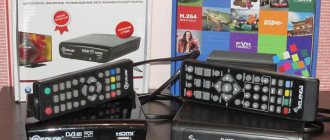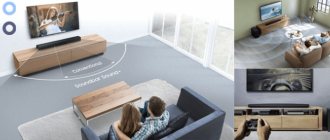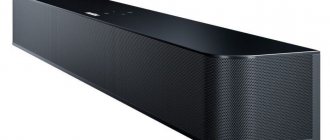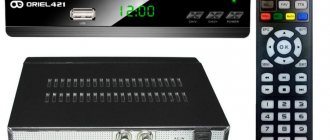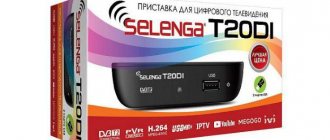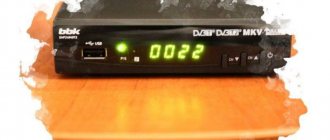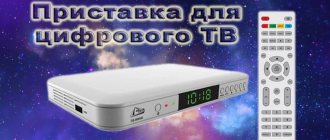Set-top boxes with Wi-Fi for digital television are becoming increasingly popular. They replace satellite and analogue connections. Digital has a number of undoubted advantages - a powerful signal, high-quality picture, good sound, interesting channels of different directions. If your TV doesn't have a built-in tuner and you're planning to buy a portable one, be sure to check out our buying guide.
DVB-T2 and Wi-Fi
Quite a bit of theory, because... Initially I did not understand the problem of the question. Let me explain in more detail:
- DVB-T2 – deals with the reception of digital terrestrial TV through a regular television antenna.
- Wi-Fi – can only connect via Wi-Fi (for example, to a router).
Now attention! To date, I have not seen any clean solutions that allow you to take a digital terrestrial TV signal out of thin air and immediately transmit it to your TV. Those. You will definitely have to get an antenna for this set-top box, but still run a cord from it to the TV. The wire connection will be like this:
Antenna – DVB-T2 set-top box – TV
What does Wi-Fi have to do with it? Initially, he had nothing to do with it. Those. The first receivers came with a single function - to receive a signal from the antenna and somehow transmit it to the TV. And in parallel, another competitor was developing...
Digital television broadcast standards
Those who have encountered digital television have noticed the presence of the DVB-T standard. It doesn’t matter what you’re looking at, a set-top box or a TV. Each device must meet the requirements to ensure full operation with DVB.
What digital television standards exist:
- DVB-S, another name for DVB-S2. In this case, you will need a satellite dish or a special decoder;
- DVB-T – digital terrestrial technology. Operation is based on an external or internal tuner;
- DVB-C - A person can watch television channels through his provider, through a specially dedicated line;
- Internet television IPTV and OTT - for viewing Smart TV, can also be used on other gadgets such as a phone or tablet.
The DVB-T2 standard is a signal modification created on the basis of DVB-T. Its main purpose is to broadcast a digital signal. Such broadcasting is carried out through television towers.
A built-in or separate TV tuner for your TV helps receive the signal. Also, these devices have additional functions that will be useful to the user. A TV tuner can make even an old TV show high quality images.
Note! When using a tuner, a connection to an over-the-air antenna is required. This type of antenna is capable of picking up a digital signal.
The main advantage of the device is that you can receive a signal anywhere in Russia, even in the country. In this case, the consumer will not be required to pay additionally for viewing channels provided in this way.
Media players
Media players... Or whatever they are called - just a media set-top box, an Android set-top box, a media center, a media server, etc. Its essence is a device, now usually based on Android, which displays an image on the screen and allows you to do everything that Android can do - connect to the Internet, play games, watch photos and videos, even those formats that the TV does not support .
Those. By purchasing such an inexpensive media player, we could expand the functionality of even the most antediluvian tube TV to a modern level. For example, this is how to use a TV as a monitor for a computer, i.e. leave the functions of image output exclusively on it, and transfer all the brains to a digital set-top box. And now the developers have found another segment...
Connecting a TV receiver with Wi-Fi
When choosing between a built-in Smart TV system and an outdoor set-top box, it is better to give preference to the second option. The digital decoder has a large number of “smart” functions. Using an external tuner, you can watch movies in popular online cinemas, download videos from Youtube, access your pages on social networks and much more. Modern set-top boxes are miniature devices with a rich set of options, and their setup is very quick.
The following instructions will tell you how to connect a digital set-top box to Wi-Fi:
- A smart device connects to a wireless network using a Wi-Fi module or router. After all devices are connected to the TV receiver, they will need to be connected, and after loading, open the main menu on the screen.
- Control is performed using a mouse or remote control. In the main menu you need to find a section called “Wi-Fi”. If this feature is not enabled by default, drag the slider to the opposite position.
- Wait a few seconds while the device searches for a list of available Wi-Fi networks. Once your home network is displayed, you will need to select it and enter a password.
- If the router is configured correctly, after activating the confirmation command, a few seconds should pass before connecting to the access point.
Connecting a tuner to a wireless network has many advantages, among which it is worth noting the absence of cables and the ability to place the TV receiver in any part of the house or apartment. If there is no Wi-Fi router, there is an alternative way to connect the Smart set-top box and TV, connecting via an Ethernet cable.
You will need to find an RJ-45 interface on the tuner body and connect a cable to it. After you enter the main menu, instead of Wi-Fi, select “Ethernet”. The connection to the Internet usually occurs automatically within a few seconds. If this does not happen, you should make a manual adjustment. If you have a computer, you can use it to go into the network connection settings and see what IP addresses are in use. They will need to be copied and pasted into the appropriate fields in the “Ethernet” section on the TV screen. The only difference is that you need to subtract one from the last digit of the IP address. This method has several disadvantages, the main one of which is the need for a separate line to connect the Smart set-top box. As for the other nuances, this method will also allow you to turn the TV receiver into a multimedia entertainment center.
Separate adapter
It is worth mentioning that some DVB-T2 set-top boxes already have a wired interface for connecting to the Internet. And for some of them, the manufacturer has included the ability to connect an external Wi-Fi adapter via the USB port. Their functionality is minimal, but they still allow you to watch some content via the Internet (for example, Youtube).
May not be compatible with your set-top box! Check with the manufacturer.
From what I saw:
Here is an adapter based on Mediatek MT7601 (Ralink MT7601). Compatibility is included in most set-top boxes Lumax, ORIEL, Selenga, Dcolor, Perfeo, World Vision, Divisat, Signal, Ether (according to the manufacturer, it was not possible to personally verify everything). 300 rubles – and the set-top box can already connect via Wi-Fi.
Connection and setup
The standard connection option is to connect a TV or receiver via a USB connector. The adapter will notify you that everything is connected correctly and the devices are ready for use. After this signal:
- turn on the TV or smart set-top box;
- go to “Settings” / “Network” / “Wireless Connection”.
After the transitions, select automatic connection, click on WPS on the router and hold for a few seconds. Communication settings occur automatically. If the settings have not started, you will need to do them manually. Follow the algorithm: go to the “Wireless connection”/Manual setup section, enter the IP address, subnet mask, gateway and DNS. A review of top models allows you to buy a set-top box for your specific needs. The price is determined by the specific manufacturer and available features.
How to choose?
Now let's get back to our DVB-T2 + Wi-Fi combination. How can you find them? I show it using the example of an online store. Nothing was found in the digital TV set-top box section, so I had to search among media players (but I recommend that you search in all categories).
My filters:
- Category – media player.
- TV tuner – DVB-T2.
- Wi-Fi module – built-in.
And there were only 3 of these:
I suggest taking a brief look at each of them.
Principle of operation
A digital receiver with Wi-Fi for a TV has two main functions, they work according to the following principle.
- The built-in DVB-T2 tuner converts the analog signal and provides access to free digital TV.
- The built-in Wi-Fi adapter receives the signal from the router and provides Internet access. Moreover, depending on the model, the user may either have limited functionality - built-in access to cinema halls and several pre-installed services, or the set-top box has an operating system (mainly Android), which opens up broader functions. If the OS is installed, the TV becomes a full-fledged analogue of Smart TV.
iconBIT XDS804T2
- 4K support
- HDMI, RCA, 2 USB
- Network port (up to 100 Mbps)
- Android 7
- 8 GB internal memory
This is where I will probably end the review. Think carefully - do you really need to connect a DVB-T2 set-top box or have we completely dispelled your myths? In any case, you can safely leave questions and additions in the comments below to this article. We are always happy to hear someone else's opinion or answer a question!
Official map of digital TV coverage in Russia from RTRS
How to choose and connect a Wi-Fi adapter to a TV set-top box on Android
The official map will help a person determine the location of digital TV towers within the Russian Federation. It also helps you find out:
- At what distance is the nearest repeater?
- Is this object working?
- Channel and frequency;
- Frequency zones;
- Where can you purchase the necessary equipment.
Important! The map is automatic and the data is updated regularly. Therefore, you can enter your address at any time and get all the necessary information.
Comparative table of characteristics of digital set-top boxes
To make it easier for customers to choose a DVB-T2 set-top box, a special table has been compiled. Below is a list of popular devices and their characteristics. Here you can clearly see the difference between the models. The main difference lies in the installed processors and the number of USB connectors. Experts advise giving preference to those devices that best suit your needs. The average price indicated in the table will allow you to understand which models fit into your budget.
| Console | CPU | Digital standards | Number of USB connectors | Display | Exits | average price |
| Oriel 421D | GX 3235S | DVB-C, DVB-T, DVB-T2 | 2 | Eat | Lumax DV-1110HD | RUB 1,415 |
| Selenga HD950D | GX3235S | DVB-C, DVB-T, DVB-T2 | 2 | Eat | audio, HDMI, composite | RUB 1,141 |
| World Vision T62D | GX3235S | DVB-C, DVB-T, DVB-T2 | 2 | Eat | audio, HDMI, composite | 990 rub. |
| World Vision Foros Combo | GX6605 | DVB-C, DVB-S, DVB-S2, DVB-T, DVB-T2 | 2 | Eat | audio, HDMI, composite | 1,800 rub. |
| World Vision Premium | Ali 3821 | DVB-C, DVB-T, DVB-T2 | 2 | Eat | audio, HDMI, composite | 3,000 rub. |
| D-Color DC1802HD | GX3235S | DVB-C, DVB-T, DVB-T2 | 1 | Eat | audio, HDMI, composite | RUR 1,115 |
| World Vision T62A | GX3235S | DVB-C, DVB-T, DVB-T2 | 2 | Eat | audio, HDMI, composite | RUB 1,150 |
| Harper HDT2-1514 | MSTAR 7T01 | DVB-T, DVB-T2 | 1 | Eat | audio, HDMI, composite | 800 rub. |
| World Vision T64D | Availink 1506T | DVB-T, DVB-T2 | 2 | Eat | audio, HDMI, composite | 950 rub. |
| Selenga T81D | GX3235S | DVB-C, DVB-T, DVB-T2 | 2 | Eat | audio, HDMI, composite | 800 rub. |
| Oriel 403D | GX3235S | DVB-C, DVB-T, DVB-T2 | 2 | No | audio, HDMI, composite | 740 rub. |
| Lumax DV-1110HD | GX3235S | DVB-T2 | 1 | No | audio, HDMI, composite | 890 rub. |
Main characteristics
It is worth considering several basic technical characteristics of the adapters described above. These are the ones you should use to select when purchasing.
TV Compatibility
Any wifi adapter for a dvb t2 set-top box comes with instructions and descriptions that indicate which TV models and manufacturers it is compatible with. Before purchasing, you need to make sure that the adapter will work correctly with the TV. Sometimes only supported brands are written on the packaging. This means that the module will work with all models of these brands. If the wireless module is not supplied with the TV, then its technical characteristics are indicated by the manufacturer in the equipment passport or on the official support website.
Transmitter power
One of the most ambiguous parameters, since it can be quite difficult to determine the range of the device. Increasing the power of radio waves is only possible on the side of the router acting as an access point.
Important! In order for the signal to be transmitted with high quality and without delays, the power of the wireless communication module must be at least 17 dBm. Often the power is indicated on the product packaging
Operating frequency
This parameter, on the contrary, is one of the most important, since it is the determination of the required operating frequency of the adapter that will solve many compatibility problems. The router that is the access point and the adapter must have the same operating frequency.
Signal standard
Data transfer speed is as important as the operating frequency of the device. It is directly determined by the signal standard, which is important for a quality connection. This setting must also match the standard of the router or other access point. There are two types of speed: real and maximum, specified in the description of the standard’s throughput. Speed is measured in Mbit/s. At the moment, there are several popular standards with their own characteristics and speed range:
- A, with a real speed of 2 Mbit/s, and a maximum speed of 5 Mbit/s;
- B, 3/11 Mbit/s;
- G, 24/54 Mbit/s;
- N, 50/150 Mbit/s;
- N Dual Band, 150/300 Mbps.
The standards are described in more detail in the picture.
Important! Maximum speed – maximum throughput. In life, it often cannot be achieved due to interference in the form of walls, furniture and other radio signals from household appliances: microwave ovens, washing machines, refrigerators. Even water absorbs radiomagnetic waves.
Signal range
A parameter that divides modules into two types: intended for use indoors or outdoors. The radius is limited and measured in meters. The larger the radius of the receiver, the further you can place it from the TV, but this will not play a role in the presence of obstacles in the form of walls and other things.
Protection and encryption methods
Any unauthorized access to data, including data transmitted via Wi-Fi, must be stopped immediately. Connecting to a router without a password at all must be problematic and almost impossible. This is precisely why methods have been invented to protect Wi-Fi connections using modern encryption methods.
The minimum protection for Wi-Fi and SmartTV is to create a network with a unique name and a complex password.
Important! Moreover, you can make the network invisible and enable data encryption via WPA, WEP or WPA2 protocols. You can find security settings using a computer using IP address 192.168.1.1
